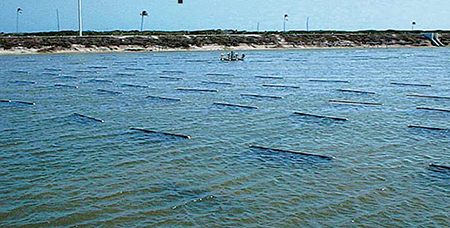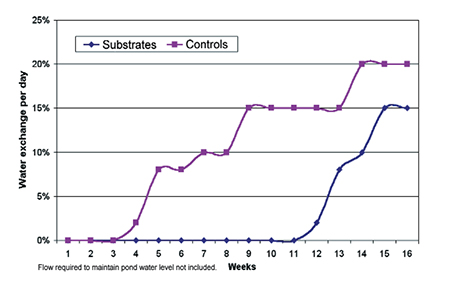Mexican shrimp farm reduced its required daily water exchange 70 percent

Industrias Pecis, S.A. de C.V., with headquarters in Merida, Yucatan, Mexico, operates a 45-ha intensive shrimp farm near the town of Sisal, on the northwest coast of the Yucatan Peninsula. In addition to the growout farm, which is currently being expanded from 30, 1.5-ha unlined ponds, Pecis also operates two large hatcheries and a packing plant.
The company has been producing L. vannamei shrimp since 1997. The farm has not had any major disease problem, and has been able to consistently improve its yields by incorporating the latest developments in biosecure, sustainable shrimp-farming technology.
Improving production technology
Through a disciplined process of investigation, evaluation, and use of new technology, Pecis has steadily increased production and profitability. Examples of this process are the development of a line of disease-free, domesticated broodstock and postlarvae; and a multiphase production system that includes the use of intensive nursery raceways and nursery ponds, probiotics, and improved feeds. After improving all phases of its operations, Pecis began work with AquaMats® substrate technology, and achieved further gains in production.
Substrate technology
A year of data evidences the importance of the substrate technology implemented in 20 percent of the ponds to date. Essentially, the substrate provides a very high amount of a surface area that is readily colonized by bacteria and benthic algae, which together behave as a huge biofilter in absorbing metabolic waste.
At the same time, the microfauna (copepods, rotifers, etc.) associated with the colonized surfaces provide an important alternative, natural food supply. The substrates also offer increased grazing area for shrimp, and refuge during molting, and can aid in the dispersion of the population.
By exploiting the biofiltration capabilities of substrate technology, Pecis has reduced its required daily water exchange 70 percent, from an average of 11 percent to 3 percent exchange.
Profitability

Financial analysis of the most recent grow-out cycle (ponds stocked in August 2000) shows that production costs averaged U.S. $3.57 per kilogram of shrimp in ponds equipped with substrates and $3.68 per kilogram of shrimp in ponds without substrates. These figures include the costs of postlarvae, feed, fertilizers, probiotics, direct labor, aeration, pumping, maintenance, harvest, processing, and insurance. Fig. 1 shows the reduced water exchange used in ponds with substrates versus ponds without substrates.
Yields were significantly increased using substrate technology, with an average 12.2 metric tons (MT) per hectare per cycle yield in ponds with substrates, compared to 8.2 MT per hectare per cycle in those without. The combination of a 3 percent reduction in operating costs and 48 percent higher yield in ponds with substrates resulted in an overall increase of 52 percent in net profit. Although the investment for installing substrate technology was significant (about U.S. $11,300 per hectare), it was recovered in less than one grow-out cycle (return on investment = 450 percent per year).
Conclusion
At Industrias Pecis’ intensive shrimp farm near Merida, Mexico, substrate technology has allowed a reduction in water exchange from 11 percent to 3 percent. It also improved profitability by increasing yields by 48 percent and reducing operating costs by 3 percent.
(Editor’s Note: This article was originally published in the April 2001 print edition of the Global Aquaculture Advocate.)
Now that you've finished reading the article ...
… we hope you’ll consider supporting our mission to document the evolution of the global aquaculture industry and share our vast network of contributors’ expansive knowledge every week.
By becoming a Global Seafood Alliance member, you’re ensuring that all of the pre-competitive work we do through member benefits, resources and events can continue. Individual membership costs just $50 a year. GSA individual and corporate members receive complimentary access to a series of GOAL virtual events beginning in April. Join now.
Not a GSA member? Join us.
Authors
-
Sergio Monroy
General Manager
Industrias Pecis, S.A. de C.V.
Merida, Yucatan, Mexico -

Jeffrey Peterson
Senior Technical Representative
Meridian Aquatic Technology, LLC
Calverton, Maryland, USA
Tagged With
Related Posts

Intelligence
Biofilters: Choosing your substrate
Heterotrophic and autotrophic bacterial communities supported within a biofilter naturally process organic wastes and provide biologically stable water.

Health & Welfare
ELISA kits offer quantitative analysis of trifluralin in fish
Antibody-based enzyme-linked immunosorbent assay (ELISA) tests are proven, sensitive, high-throughput alternatives to more costly and complex test methods for the detection of herbicide residues and other chemicals.

Responsibility
Freshwater prawn farming in Thailand
While the industry faces issues, freshwater prawn farming in Thailand offers a lucrative alternative to other forms of farming on small farms.

Health & Welfare
Microbial flocs for aquaculture
Microbial flocs consist of a variety of bacteria, fungi, microalgae and other organisms suspended with detritus in culture water.


